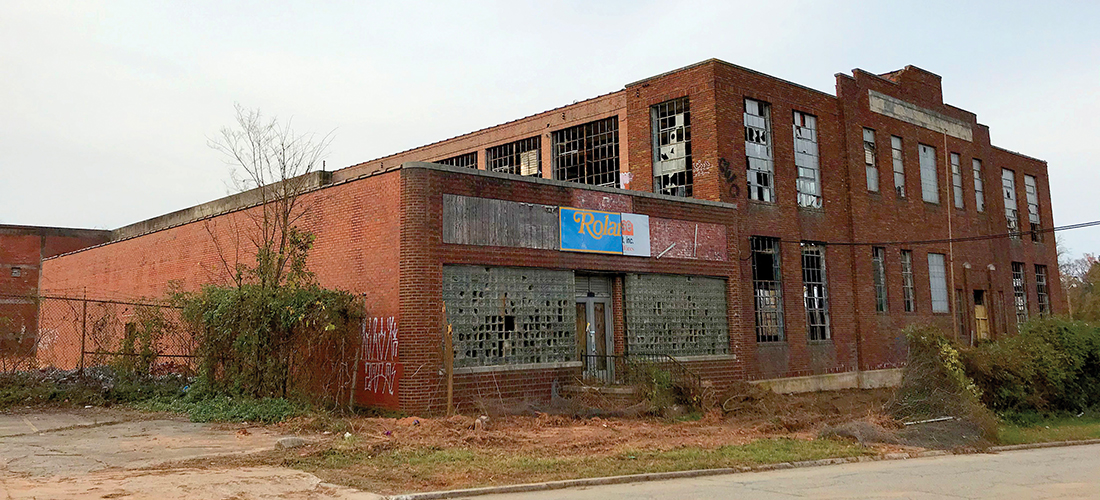
Rise of the Mill
A glimpse of Greensboro’s past and present
By Billy Eye
Good design is obvious. Great design is transparent. — Joe Sparano
Following the vibrant reemergence of Greensboro’s Mill District — the Cone family’s Revolution Mill and Printworks Mill now thriving as multiuse commercial and residential hubs — another dilapidated manufacturing plant is undergoing a multimillion-dollar reimagining for what promises to be a spectacular setting for 170 apartments and townhomes.
That explains the hive of activity in and around a former, venerable hosiery mill located on Howard Street. It’s close to the railroad tracks near the west end of UNCG’s campus — behind Hops Burger Bar and Bites & Pints Gastro Pub on Spring Garden.
The property dates back to 1926 when three manufacturers from New York, Bernard Mock, Nathaniel Judson and John K. Voehringer, formed the Mock, Judson, Voehringer Company of North Carolina. It operated out of a 10,000-square-foot building adjacent to the rail lines on Oakland Avenue and originally hired 14 workers. Over time, the enterprise morphed into a leading producer of women’s silk stockings, Mojud Hosiery Company.
Over the next decade, undeterred by the Great Depression, the company employed some 600 workers, the overwhelming majority of them female, and was producing more than 4 million pairs of nylon hosiery by 1928. In fact, Mock, Judson, Voehringer was one of the primary employers of the county’s working women — an alternative to rolling stogies for the El-Rees-So Cigar Company. The complex eventually expanded to 140,000 square feet.
In 1938, a retail outlet was established at the mill to showcase the Mojud brand ladies’ lingerie produced on site, quite possibly making it the nation’s first outlet store. In those early days, customers took a number and lined up outside to gain admittance so as to not crowd the store.
No less than Charles C. Hartmann — the architect responsible for the Jefferson Standard Building and the Central Fire Station on Greene Street (as well as some of the city’s finest homes) — was called in to design some plant additions, a storefront and an attached Art Deco inspired office festooned with glass bricks.
This was the largest such facility in the South by the 1940s, and the first in the South to manufacture elegant chiffon hosiery. The company’s advertising campaigns featured movie stars like Rita Hayworth, Virginia Mayo and Ginger Rogers, who famously danced 27 miles in Mojud’s “Magic Motion” sheer stockings. The company’s mascot, Mojud Man, was a Cupid-like character designed by Vic Herman, the illustrator who also created Elsie the Cow for Borden Dairy Company, Reddy Kilowatt and Harvey Comics’ Little Dot.
During World War II, with all silk and nylon redirected for making parachutes, the plant switched over to making rayon hosiery. After the war ended, pent-up demand for the real thing reinvigorated the company with three shifts of 2,000 employees working nonstop to produce some 19 million pairs of nylons a year.
Because temperature control was crucial to the process, when air conditioning was introduced in the late-1940s, all of the windows ringing the facility were bricked in. Today, they are being uncovered so that daylight can once again brighten the interior. In the 1950s, Mock, Judson, Voehringer officially rebranded itself as Mojud Hosiery.
It took a (mill) village to make the Cone manufacturing plants successful. Like other textile giants, Cone built villages to house its employees (five in Greensboro), and added churches, schools, ballfields and company stores to lure workers.
Mojud was the odd duck that didn’t cocoon its employees in a morning-to-night experience with company-provided housing and other amenities. Instead, their workers populated the up-and-coming Lindley Park and Highland Park neighborhoods and dined in the plant’s cafeteria between shifts.
The company published its own monthly magazine, The Mojud Singer, which featured employee comings and goings, birth announcements and scoreboards for their championship winning men and women’s basketball teams.
Around 1956, after the company was purchased by Burlington-based Kayser-Roth Corporation, the former Mojud store became a Rolane Factory Outlet, which remained open on the site long after the plant was shuttered in 1972.
Rolane was a popular destination for back-to-school clothing, jeans, socks and an aromatic pink skin lotion sold at the checkout counter next to the Jordan Almonds. If I got a new car coat or windbreaker as a youngster, it likely came from Rolane. Eventually, Rolane expanded to more than 40 locations, including a storefront at Golden Gate Shopping Center.
Listed on the National Register of Historic Places in 2011, for over 30 years the property has been subject to the cruelties of the environment but has served as a sprawling brick canvas for graffiti artists of varying levels of talent.
Mark Spangenberg of Durham-based Belk Architecture is spearheading the project following Belk’s very successful reinvention of the Revolution Mill, as well as Durham’s Brightleaf Square and American Tobacco Campus. Despite being largely abandoned for nearly half a century, the original masonry structure of the manufacturing plant remains fully intact — “good bones” as they call it — making this hulking structure an ideal candidate for a restoration estimated to cost in excess of $20 million.
The same crew that brought Revolution Mill back to life, general contractor CT Wilson and their team, are in the early stages of construction with electricians restoring the old gal’s spark. Heavy machinery will clear away a forest of weeds grown thick and tall as trees on the south side of the property, where a pool and recreation center will be located. And craftsmen are busy refurbishing the signature wooden staircase and a heavy timber structure at the building’s east end.
The extant two-story atrium in the common area of the complex will serve as a communal space, while the adjacent boiler house and smokestack will be integrated into the campus.
Attorney and developer Mark Bouldin of St. Petersburg, Fla., purchased the 8.7-acre property three years ago from former owner Marty Kotis. Kotis had unveiled ambitious and preliminary plans for what is now being called the Judson Mock Project back in 2001. Objections came not from adjacent neighborhoods or UNCG, aka “the usual suspects,” but from the Sherwin-Williams paint distribution center across Howard Street. They were concerned about additional traffic impeding their operations, as well as escaping paint fumes bothering future tenants. Those issues were addressed, and Sherwin-Williams has since acquiesced, allowing the project to proceed without impediment.
As our city embraces the future, increasingly it is our antiquated industrial infrastructure — which until very recently was considered a gargantuan eyesore — that lights the way, defining how we live and interact in a world that would have seemed unimaginable to those three businessmen from New York who dared to venture South so long ago. OH
Billy Eye, a former Hollywood movie-poster designer who grew up in and currently resides in Greensboro, would love to wear his Rolane car coat if he still had it.





